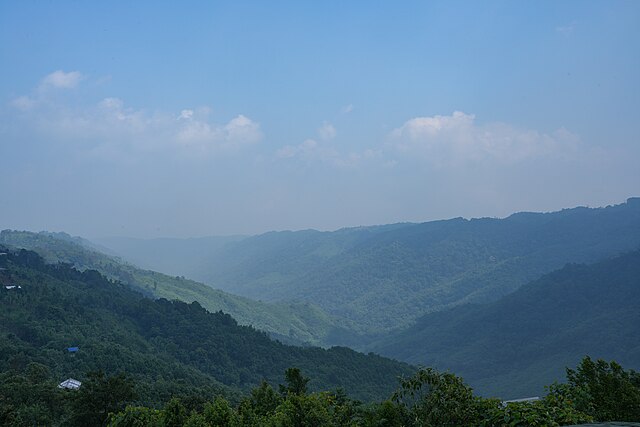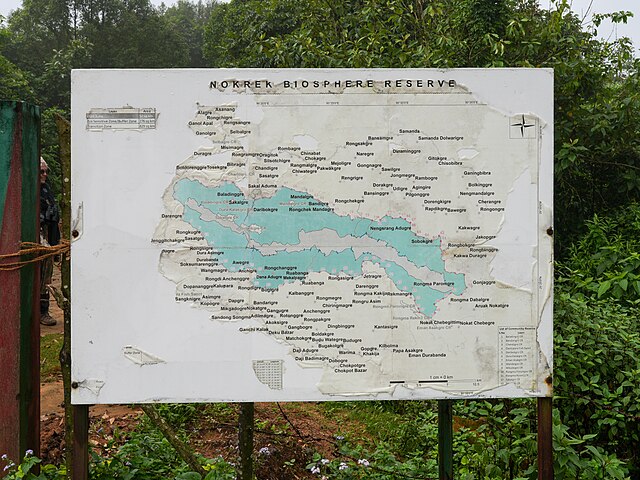Tucked away in the lush hills of Meghalaya, Nokrek National Park stands as one of India’s most pristine wilderness areas. Have you ever wondered what it feels like to step into a world where nature reigns supreme? This incredible biosphere reserve offers exactly that experience – a journey into untouched landscapes where rare species thrive and ancient forests whisper stories of conservation success.
What Makes Nokrek National Park Special?
Nokrek National Park isn’t just another protected area on India’s map. It’s a living laboratory where biodiversity flourishes in ways that’ll leave you absolutely amazed. Established in 1986, this 47.48 square kilometer sanctuary has earned its place as one of the most ecologically significant regions in Northeast India.
Location and Geography
Nestled in the West Garo Hills district of Meghalaya, Nokrek National Park sits at an elevation ranging from 400 to 1,412 meters above sea level. The park’s terrain is like nature’s own roller coaster – undulating hills, deep valleys, and pristine streams create a landscape that’s both challenging and breathtaking.
The park gets its name from Nokrek Peak, the highest point in the Garo Hills range. This towering summit serves as a natural watchtower, offering panoramic views that stretch across the verdant hills of Meghalaya and into neighboring Bangladesh.
UNESCO Biosphere Reserve Status
Here’s where things get really exciting – Nokrek holds the prestigious UNESCO Biosphere Reserve designation since 2009. But what does this mean for you as a visitor? It means you’re stepping into a globally recognized hotspot of biodiversity, where every tree, every bird call, and every rustling leaf is part of a carefully protected ecosystem.
This status isn’t just a fancy title. It represents years of dedicated conservation work and international recognition of the park’s unique ecological value. When you visit Nokrek, you’re not just sightseeing – you’re witnessing conservation in action.
Rich Biodiversity: Flora and Fauna
Think of Nokrek as nature’s own treasure chest, packed with species you won’t find anywhere else on Earth. The park’s biodiversity is staggering, with over 600 plant species calling this place home.
Unique Plant Species
The forest canopy here tells a story of evolution and adaptation. Tropical evergreen and semi-evergreen forests dominate the landscape, creating a green cathedral that filters sunlight into dancing patterns on the forest floor. You’ll encounter towering trees like Dipterocarpus, Artocarpus, and Ficus species that have stood sentinel for decades.
But it’s not just about the big trees. The understory bursts with ferns, orchids, and countless medicinal plants that local communities have used for generations. Walking through these forests feels like flipping through the pages of a botanical encyclopedia.
The Famous Nokrek Citrus
Here’s something that’ll blow your mind – Nokrek is home to the wild ancestor of all citrus fruits! The Citrus indica, found exclusively in this region, is considered the progenitor of all citrus varieties worldwide. Imagine tasting a fruit that’s essentially the great-great-grandmother of every orange, lemon, and lime you’ve ever eaten.
This discovery has made Nokrek internationally famous among botanists and fruit enthusiasts. It’s like finding the missing piece of a puzzle that explains how citrus fruits spread across the globe.
Wildlife Diversity
The animal kingdom in Nokrek reads like a who’s who of Asian wildlife. From tiny insects to magnificent elephants, the park supports an incredible range of species. You might spot the elusive red panda, hear the haunting call of hornbills, or catch a glimpse of the rare golden langur.
The park is home to over 200 bird species, making it a paradise for birdwatchers. Imagine waking up to a symphony of calls from great hornbills, white-winged wood ducks, and countless other feathered residents.
Endangered Species Protection
Nokrek serves as a crucial refuge for several endangered species. The park’s elephant population, though small, represents a vital link in the corridor connecting elephant habitats across Northeast India. These gentle giants face numerous challenges, and Nokrek provides them with a safe haven.
Other endangered species include the hoolock gibbon, whose calls echo through the forest canopy, and various species of pheasants that add splashes of color to the understory.
Best Time to Visit Nokrek National Park

Timing your visit to Nokrek is crucial for the best experience. The park is open year-round, but different seasons offer different advantages.
Weather Patterns Throughout the Year
The ideal time to visit is between October and March when the weather is pleasant and wildlife activity is at its peak. During these months, temperatures range from 15°C to 25°C, making trekking and outdoor activities comfortable.
Summer months (April to June) can be quite warm, with temperatures reaching up to 35°C. However, this is also when many flowers bloom, creating spectacular displays of color throughout the forest.
Monsoon Considerations
The monsoon season (July to September) transforms Nokrek into a lush green paradise, but it also brings challenges. Heavy rainfall can make trails slippery and difficult to navigate. However, if you don’t mind getting wet, the monsoon season offers incredible photographic opportunities as waterfalls come alive and the forest canopy becomes impossibly green.
How to Reach Nokrek National Park
Getting to Nokrek requires some planning, but the journey is part of the adventure. The nearest town is Tura, which serves as the gateway to the park.
By Air
The closest airport is Lokpriya Gopinath Bordoloi International Airport in Guwahati, approximately 220 kilometers away. From there, you’ll need to take a road journey to Tura, which takes about 5-6 hours through scenic hill roads.
By Road
Tura is well-connected by road to major cities in the region. Regular bus services operate from Guwahati, Shillong, and other nearby towns. The road journey offers stunning views of the Meghalaya countryside, with rolling hills and traditional villages dotting the landscape.
By Rail
The nearest railway station is Goalpara in Assam, about 130 kilometers from Tura. From there, you can hire a taxi or take a bus to reach the park.
Activities and Attractions
Nokrek isn’t just about passive observation – it’s about immersing yourself in nature’s playground.
Trekking and Nature Walks
The park offers several trekking routes that cater to different fitness levels. The trek to Nokrek Peak is the most popular, offering panoramic views that’ll make every step worth it. The trail winds through dense forests, across streams, and up steep slopes that challenge even experienced trekkers.
For those preferring gentler walks, numerous nature trails meander through the lower elevations, offering excellent opportunities to observe wildlife and enjoy the forest’s tranquility.
Bird Watching
With over 200 bird species, Nokrek is a birdwatcher’s dream come true. Early morning hours are particularly rewarding, as the forest comes alive with bird calls and activity. The great hornbill, with its distinctive casque and massive wingspan, is a particular highlight.
Photography Opportunities
Every corner of Nokrek offers photographic gold. From macro shots of rare orchids to landscapes that stretch to the horizon, photographers will find endless subjects. The interplay of light and shadow in the forest creates magical moments throughout the day.
Accommodation Options
Staying near Nokrek requires some planning, as accommodation options are limited but adequate for most visitors.
Forest Rest Houses
The Meghalaya Forest Department operates rest houses within and near the park. These basic but comfortable accommodations offer the unique experience of staying within the forest itself. Booking in advance is essential, especially during peak season.
Nearby Hotels and Resorts
Tura offers several accommodation options, from budget guesthouses to mid-range hotels. While not luxurious, these establishments provide clean, comfortable stays and serve as excellent bases for exploring the park.
Conservation Efforts and Challenges
Nokrek’s success story is built on dedicated conservation efforts, but challenges remain.
Community Involvement
Local Garo communities play a crucial role in conservation efforts. Their traditional knowledge and practices contribute significantly to protecting the park’s biodiversity. Many community members work as guides, sharing their intimate knowledge of the forest with visitors.
Environmental Threats

Like many protected areas, Nokrek faces threats from human encroachment, climate change, and resource extraction pressures. Ongoing efforts focus on balancing conservation needs with local development requirements.
Planning Your Visit: Essential Tips
A successful visit to Nokrek requires careful planning and preparation.
Permits and Regulations
Visitors need permits from the Meghalaya Forest Department to enter the park. These can be obtained in Tura or through authorized tour operators. It’s essential to follow all park rules and regulations to ensure both your safety and the protection of the ecosystem.
What to Pack
Pack light but smart. Essential items include sturdy hiking boots, rain gear, insect repellent, sunscreen, and a good camera. Don’t forget binoculars for wildlife viewing and a first-aid kit for safety.
Conclusion
Nokrek National Park represents everything that makes India’s wilderness areas special – incredible biodiversity, stunning landscapes, and the opportunity to connect with nature in its purest form. Whether you’re a serious naturalist, an adventure seeker, or simply someone looking to escape the hustle and bustle of modern life, Nokrek offers experiences that’ll stay with you forever.
This hidden gem in Meghalaya’s hills isn’t just a destination – it’s a reminder of what we stand to lose if we don’t protect our natural heritage. Every visit to Nokrek is a vote for conservation, a step toward understanding our planet’s incredible diversity, and a chance to create memories that’ll last a lifetime.
So pack your bags, lace up your hiking boots, and prepare for an adventure that’ll change how you see the natural world. Nokrek National Park is waiting to show you wonders you never knew existed.
FAQs
1. Is Nokrek National Park safe for solo travelers?
Yes, Nokrek is generally safe for solo travelers, but it’s recommended to hire a local guide for safety and to enhance your experience. The park authorities maintain good security, and local communities are helpful and friendly.
2. What is the entry fee for Nokrek National Park?
Entry fees vary for Indian and foreign nationals, with additional charges for cameras and vehicles. It’s best to check current rates with the Meghalaya Forest Department or your tour operator before visiting.
3. Can I camp inside Nokrek National Park?
Camping is allowed in designated areas with proper permits. However, facilities are basic, and you’ll need to bring your own equipment. Forest rest houses offer a more comfortable alternative.
4. What makes the Nokrek citrus so special?
The Citrus indica found in Nokrek is considered the wild ancestor of all citrus fruits worldwide. This makes it incredibly important for genetic diversity and understanding the evolution of citrus species.
5. How physically demanding is trekking in Nokrek?
Trekking difficulty varies by route. The Nokrek Peak trek is challenging and requires good fitness levels, while shorter nature walks are suitable for most visitors. Always assess your fitness level and choose appropriate trails.

